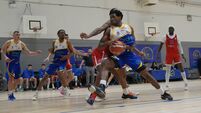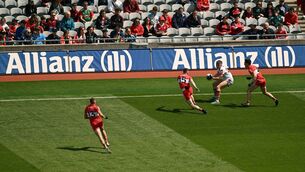Clashes of the ash short on innovation
Has there been great tactical innovation? Those left dumbstruck by Tipperary’s goal rush last weekend, or Kilkenny’s dissection of Dublin a couple of weeks beforehand, won’t have noticed any grand designs.
Both teams withdraw downfield and break back onto the ball in space near the opposition goal to raise the green flags. You say it like that and it sounds simple to defend against, which of course it isn’t, but you don’t have to re-invent the wheel.
One of the most successful American football teams of all time, the Green Bay Packers, had three offensive plays.
They won so much because they executed them so exactly and ruthlessly that other teams were powerless to stop them. Sound familiar? Apart from that teams haven’t sparkled with invention. Donal O’Grady has patented a match-starting ploy whereby his Limerick forwards all congregate at the centre-forward slot before breaking off to their positions when the ball’s thrown in.
(We’ll spare the name of the soldier who trooped dutifully into this allotted slot at the beginning of the Wexford game, making the marking job a tad easier for the defender assigned to him.)
Something that struck this observer in recent weeks is a small but significant tell, as the poker players among you might call it, among close-in free-takers.
Every big team carries a specific goal threat from the dead ball, someone with a ferocious shot who can go for goal at any distance from 30 yards inwards. Yet almost every free-taker gives the game away with that exaggerated run-up, a signal to the person sitting at the back of the stand that they’re going for goal.
Before you all shout that every long run-up doesn’t automatically result in a shot for goal, consider that no free-taker takes a long run-up for every close-in free. Common sense would tell a free-taker that if he were to take those two or three steps to approach every time — even if he planned to put most of them over the bar — then the opposing defenders would be in the dark about his real intentions until the last second.
As it is, the men on the goal-line can make a fair guess even before the ball is struck: who wants to make it easy for them?
As for some of those on the line... has anyone noticed goalkeepers falling backwards lately? Even at the elite level there seem to be a lot of netminders going backwards instead of forwards when someone takes a shot on goal this season. Check out YouTube if you don’t believe us.
Another small point? Maybe, but it counts. Inclining yourself at a forward angle before the shot arrives means the ball is less likely to get past; lean backwards and the sliotar can skim off hurley or body and onwards to the net. Simple physics.
At least one intercounty goalkeeper remedied that tendency in his own play by practicing with cricket pads — kitted out in the protective gear he was less likely to flinch when a ball came flying towards him, a habit he imported successfully into his hurling career.
Looking to other sports for help is something you’d expect to see a little more often in hurling, come to that. The classic argument against is that hurling isn’t like other sports, when in fact hurling is very like at least one other sport — a sport that you’d imagine skills coaches in hurling would pay a lot of attention to.
Having recently spent some weeks receiving golf tuition from golf pro John McHenry, this writer is surprised every serious hurling coach doesn’t draw on the expertise of a top golfer with his players.
It was interesting last year to chat to Eamonn O’Shea, the highly regarded former Tipperary coach, and hear him refer to the tennis rackets he’d given his charges. In order to teach them to recognise a good connection with the ball by ear he branched out to a different sport.
Given the number of sideline cuts, for instance, in even a top-flight intercounty game, it’d surely repay a coach to get a golf professional in to see his players and to critique their striking, rhythm, approach, alignment and address.
We tend to see the sideline as a means of simply restarting the game, unless you’re Joe Canning or Ben O’Connor, yet how often do you see a sideline cut that doesn’t even beat the first knot of players standing between the taker and the goalposts? A small point, but victory relies on getting all the small points together.
* Contact: michael.moynihan@examiner.ie Twitter: MikeMoynihanEx











